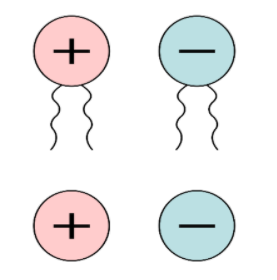
The sexual reproduction in Spirogyra is
a. Oogamous
b. Isogamous
c. Cleistogamous
d. Conjugation
Answer
510.6k+ views
Hint: Sexual reproduction in spirogyra occurs by the fusion of male gamete and female gametes. These two types of gametes i.e. male and female gametes are non-flagellated, non-motile but similar in size.
Complete step-by-step solution:
Spirogyra reproduces by all the modes i.e. sexual, asexual, and vegetative where sexual reproduction occurs by fusion of the two gametes, one male and other a female. Here, the gametes are similar in size but non-flagellated and hence non-motile. This type of reproduction involving a similar size of gametes is called Isogamous. A representative diagram of isogamy has been given below –

Additional information
-Asexual reproduction occurs by the formation of different types of spores like azygospores, akinetes, or aplanospores.
-Under favorable conditions, it prefers to reproduce vegetatively which occurs by fragmentation. After fragmentation, the vegetative fragment develops into a new filament by undergoing multiple divisions and elongations.
-Aplanospores are formed in unfavorable conditions by shrinkage of protoplast. Akenetes are also formed similarly to the aplanospores and these are non-motile spores. In favorable conditions, they form new filaments after the decay of parent one.
-Azygospores are parthenospores and in actual sense, these are the gametes that failed to fuse during sexual reproduction and thus they developed in a new filament asexually.
So, the correct answer is ‘Isogamous’.
Note:
-In oogamous type of sexual reproduction, there is a condition of anisogamy because in this type the female gametes are slightly larger than the male gametes.
-Cleistogamous type of reproduction involves self-pollination and is well known in some plants like peas, pancy, and peanuts.
Complete step-by-step solution:
Spirogyra reproduces by all the modes i.e. sexual, asexual, and vegetative where sexual reproduction occurs by fusion of the two gametes, one male and other a female. Here, the gametes are similar in size but non-flagellated and hence non-motile. This type of reproduction involving a similar size of gametes is called Isogamous. A representative diagram of isogamy has been given below –

Additional information
-Asexual reproduction occurs by the formation of different types of spores like azygospores, akinetes, or aplanospores.
-Under favorable conditions, it prefers to reproduce vegetatively which occurs by fragmentation. After fragmentation, the vegetative fragment develops into a new filament by undergoing multiple divisions and elongations.
-Aplanospores are formed in unfavorable conditions by shrinkage of protoplast. Akenetes are also formed similarly to the aplanospores and these are non-motile spores. In favorable conditions, they form new filaments after the decay of parent one.
-Azygospores are parthenospores and in actual sense, these are the gametes that failed to fuse during sexual reproduction and thus they developed in a new filament asexually.
So, the correct answer is ‘Isogamous’.
Note:
-In oogamous type of sexual reproduction, there is a condition of anisogamy because in this type the female gametes are slightly larger than the male gametes.
-Cleistogamous type of reproduction involves self-pollination and is well known in some plants like peas, pancy, and peanuts.
Latest Vedantu courses for you
Grade 7 | CBSE | SCHOOL | English
Vedantu 7 CBSE Pro Course - (2025-26)
School Full course for CBSE students
₹45,300 per year
EMI starts from ₹3,775 per month
Recently Updated Pages
Master Class 10 General Knowledge: Engaging Questions & Answers for Success

Master Class 10 Computer Science: Engaging Questions & Answers for Success

Master Class 10 Science: Engaging Questions & Answers for Success

Master Class 10 Social Science: Engaging Questions & Answers for Success

Master Class 10 Maths: Engaging Questions & Answers for Success

Master Class 10 English: Engaging Questions & Answers for Success

Trending doubts
A boat goes 24 km upstream and 28 km downstream in class 10 maths CBSE

Why is there a time difference of about 5 hours between class 10 social science CBSE

The British separated Burma Myanmar from India in 1935 class 10 social science CBSE

The Equation xxx + 2 is Satisfied when x is Equal to Class 10 Maths

Chandigarh is the capital of A Punjab B Haryana C Punjab class 10 social science CBSE

Change the following sentences into negative and interrogative class 10 english CBSE




